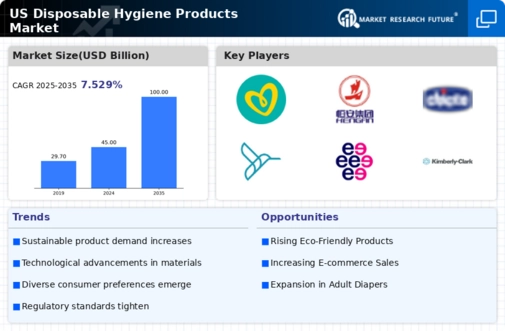The disposable hygiene-products market is characterized by a competitive landscape that is both dynamic and multifaceted. Key growth drivers include increasing consumer awareness regarding hygiene, rising disposable income, and a growing emphasis on sustainability. Major players such as Procter & Gamble (US), Kimberly-Clark (US), and Johnson & Johnson (US) are strategically positioned to leverage these trends. Procter & Gamble (US) focuses on innovation and sustainability, aiming to reduce its environmental footprint through eco-friendly product lines. Kimberly-Clark (US) emphasizes digital transformation and supply chain optimization, enhancing operational efficiency and customer engagement. Collectively, these strategies shape a competitive environment that is increasingly focused on sustainability and technological advancement.
In terms of business tactics, companies are localizing manufacturing to reduce lead times and enhance responsiveness to market demands. Supply chain optimization remains a critical focus, particularly in light of recent global disruptions. The market structure appears moderately fragmented, with several key players exerting significant influence. This fragmentation allows for niche players to emerge, yet the collective strength of major companies like Procter & Gamble (US) and Kimberly-Clark (US) continues to dominate market dynamics.
In October 2025, Procter & Gamble (US) announced a partnership with a leading technology firm to develop AI-driven solutions for product development and consumer engagement. This strategic move is likely to enhance their innovation capabilities, allowing for more personalized product offerings and improved customer experiences. The integration of AI into their operations may also streamline supply chain processes, further solidifying their market position.
In September 2025, Kimberly-Clark (US) launched a new line of biodegradable diapers, reflecting a growing consumer demand for sustainable products. This initiative not only aligns with global sustainability goals but also positions the company as a leader in eco-friendly hygiene solutions. The introduction of these products could potentially attract environmentally conscious consumers, thereby expanding their market share.
In August 2025, Johnson & Johnson (US) expanded its manufacturing capabilities in the US by investing $50 million in a new facility dedicated to producing sustainable hygiene products. This investment underscores the company's commitment to sustainability and local production, which may enhance its competitive edge in a market increasingly driven by eco-conscious consumers.
As of November 2025, current competitive trends indicate a strong shift towards digitalization, sustainability, and AI integration within the disposable hygiene-products market. Strategic alliances are becoming increasingly important, as companies seek to enhance their technological capabilities and sustainability efforts. The competitive landscape is likely to evolve, with a noticeable shift from price-based competition to a focus on innovation, technology, and supply chain reliability. This evolution suggests that companies that prioritize these areas will be better positioned to differentiate themselves in a crowded market.

















Leave a Comment